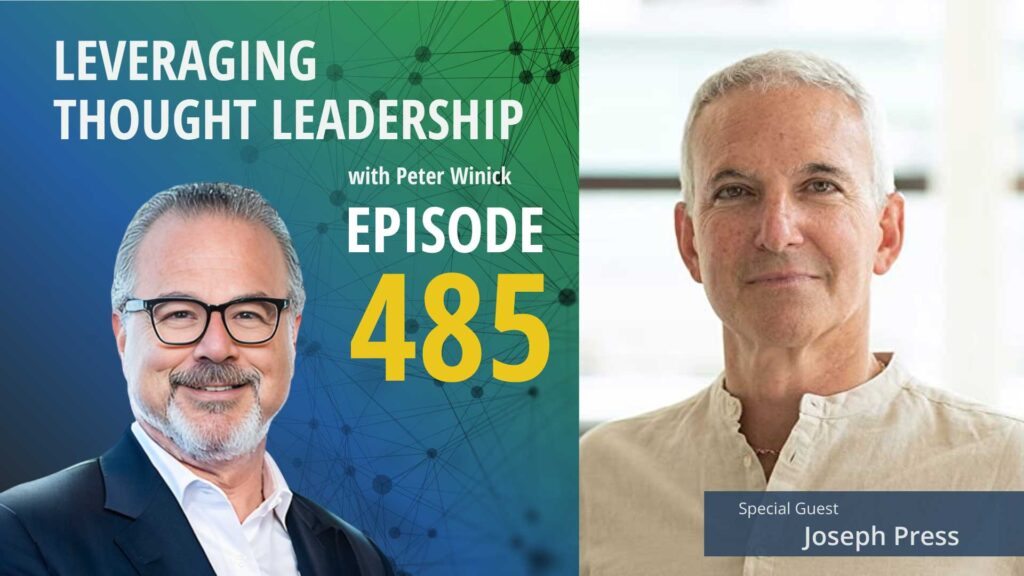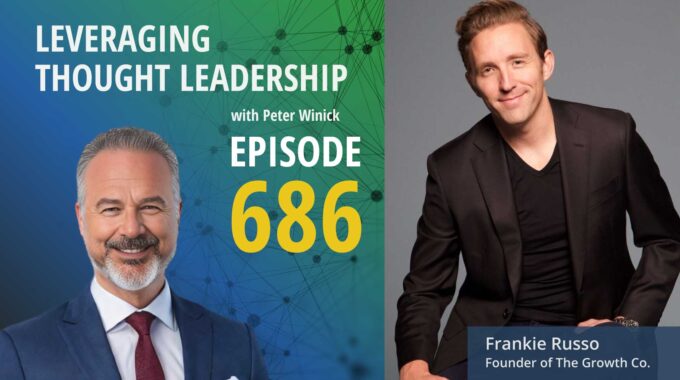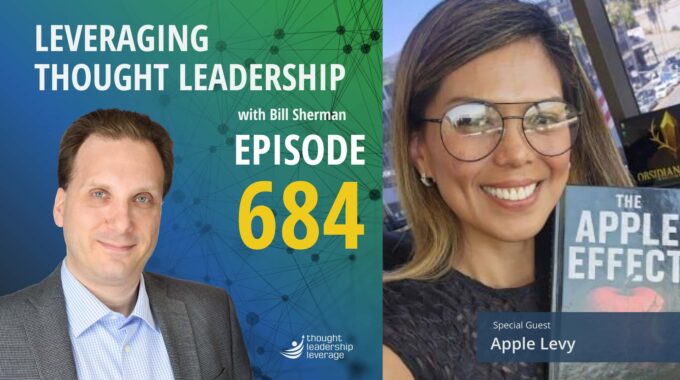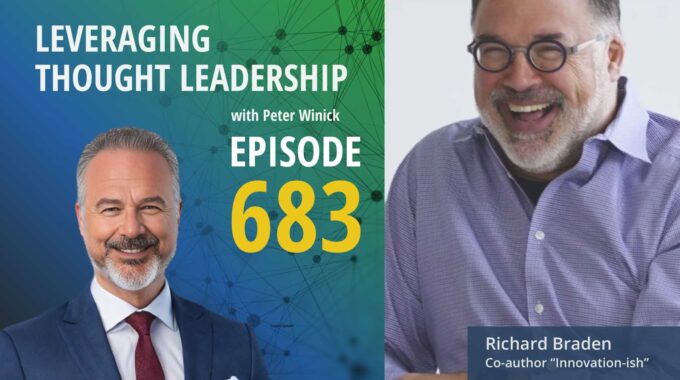How “collective genius” drives continuous growth. This episode shows how to scale thought leadership beyond…
Thought Leadership for Future Thinking | Joseph Press

Transforming leaders to future proof their business.
An interview with Joseph Press about helping leaders changes to embrace more sustainable business models and practices.
“Office shock” is the term for an abrupt, unsettling change in where, when, how, and even why we work.
Over the last few years, we have seen an abnormally large number of these events,
So how are thought leaders working to be prepared for an uncertain future?
To get a better understanding of how to thrive in unpredictable times, I’ve invited Joseph Press to join me. Joseph is the Co-Founder of Make Our Future, a global consulting cooperative dedicated to transitioning organizations to more sustainable and equitable practices.
Joseph takes us inside the pages of his new book Office Shock: Creating Better Futures for Working and Living, which focuses on leaders in organizations that have a need to contribute and change both their business practices and culture.
The success of Office Shock hinges on it touching a nerve with those leaders, helping them to realize they have an opportunity to make the changes that are needed to build a better future for everyone. Once they do, Joseph’s insights help leaders become ready for any changes the future has in store.
Joseph shares why leaders need to think outside the box, going back to creating things and focusing on engaging others in collective action. Only by approaching this task humbly and with a sense of empathy and desire to connect with others who are different from you can we hope to create new connections, learn, and innovate.
Three Key Takeaways:
- Leaders need to be willing to remove themselves from present thinking and be more willing to think outside the now in order to be prepared for the future.
- In order for your ideas to successfully reach their audience they have to strike a nerve in a way that moves them to action.
- Leaders need to be self-aware and look inwards to understand their strengths and weaknesses before they can hope to have meaningful connections.
If you need a strategy to bring your thought leadership to market, Thought Leadership Leverage can assist you! Contact us for more information. In addition, we can help you implement marketing, research, and sales. Let us help you so you can devote yourself to what you do best.

Transcript
Peter Winick And welcome, welcome, welcome. This is Peter Winick. I’m the founder and CEO at Thought Leadership Leverage and you’re joining us on the podcast today, which is Leveraging Thought Leadership. Today, my guest is Joseph Press. He’s the co-founder of Make Our Future, a global consulting cooperative, help helping organizations transition to more sustainable practices. He’s a future futures architect at Institute for the Future we leverage is over 25 years of global experience in innovation, design and leadership to create better futures for all. So he also has a book out, let’s see, that’s Transformation in the Digital Era, which is Emerald Publishing. So without further ado, welcome aboard, Joseph.
Joseph Press Happy to be here, Peter.
Peter Winick Yeah, So let’s talk for a moment. You know, you’re incredibly accomplished as an architect, right? And now you’ve got the consulting piece. But what I want to understand is, you know, when I look at your CV, if you will, it makes sense. It tells the story. You train to this way, work this way now, working this way, create for me, and sort of in real time. What is your CV or resumé as a partner?
Joseph Press Yeah, so that’s a regression to a good question, but that’s a wonderful question. And as a thought leader, the way that I like to tell the narrative of my career, everybody’s got different twists and turns in their careers, and I’ve been very fortunate to be able to create a narrative around my career, which is the title of my first book that came out a year and a half ago, Innovate and design as leadership, what we refer to as the acronym Ideals. And the reason that’s the narrative of my career is because I spent ten years as a workplace architect, and that’s the design pizza, right? I still teach design, teach more strategic design and designing sustainable futures because the innovation is what I did as a management consultant at Deloitte Digital, doing innovation, implementing new technologies, creating new customer experiences, bringing in design for apps and websites, and then the leadership piece. I had the opportunity to spend a few years at the Center for Creative Leadership, really learning about how innovation and design bring people together and can mobilize people for collective action. That’s the challenge of transformation.
Peter Winick So when you’re creating and developing thought leadership, who is it for? Meaning who? Who is the target market? Because one of the mistakes that lots of thought leaders make is because they’re so passionate about. What they do is they answer that question with a really, really wide and broad lens when that might not be so. So when you’re creating stuff, give me a sense of who do you have in mind, whether it’s psychographic, demographic, etc., that would benefit or needs to really hear what you have to say.
Joseph Press I mean, my sense is that ideally my thought leadership is targeted at leaders in organizations that know that they need to contribute to or even change into more sustainable business models, more sustainable practices to have a culture that is more about belonging and engaging people in the organization and also outside. So most of my career, whether it be as an architect, a consultant or or a futurist, which is the pivot, I’m sure, five years ago at the Institute for the Future. And that’s why I referred to myself as a futures architect. Actually architecting Better Futures is really about getting leaders who have responsibilities for regardless of what size, but they feel a responsibility to a an employee population. They feel a responsibility for a customer and even consumer base. And they feel an obligation or a responsibility to the community that they were a part of or that their work. Because we all know that there are a lot of challenges and what we call shocks in my new book, Office Shock, that require these leaders to think differently about the future, to prepare them to lead organizations and make the hard choices so that we and they and the communities that they’re part of our able to thrive in the next ten years. There’s a lot of uncertainty out there.
Peter Winick So let me ask you something there. It sounds that the leaders that you’re talking about have a high level of awareness. They’re involved, but this might be this. Some degree a generational issue or capabilities issue. Right. So might be leaders tend to be older. We don’t have a lot of 23-year-old CEOs except in Silicon Valley. Right. So is it that they’re aware and are trying to connect either to the employee base that might be a bit younger, the changing demands of the marketplace from a buyer standpoint or how much of it is you filling in the gaps for that for them?
Joseph Press Yeah, and I think so. Our book office shop, a new one that just came out a couple of weeks ago in exactly at that audience. Now the narrative of my career is put into the book Office Shock, which is more of a business book. It’s targeted at those leaders that are hopefully, hopefully during the pandemic had the opportunity to get off the wheel, had the opportunity to get back home, had the orders stopped traveling, had the opportunity to have their kids walk in when they’re doing an online meeting. And so the reason we called it office shock was because we really felt that the shock of the pandemic stopping traveling, connecting more with family and friends, a good sense of, hey, we’re in this together. That the changes in the workplace were a trigger for these leaders to say, hey, I want to be able to, as you said, reach out to the younger generation. They’re the ones are going to inherit the planet that we are going to be leaving. So we’re really looking to get these leaders to think differently about what are the messages, what are the stories that they want to tell the next generation. Similarly, what are the new kinds of stories that they need to tell their consumers who are concerned about?
Peter Winick Sure. So on Aftershock. So that’s the that’s the newest book that’s been released recently. Let’s pretend it’s a year from today. And the book was a wild success. And then you and I made an appointment to talk a year to the day from now. And I said, You, Hey, Joseph. What? Why is it a wild success? What? What? What is what is 6 seconds look like for you for this book? How is it measured and what did it achieve that you were dreaming of?
Joseph Press So I really do think it comes down to did that office touch a nerve? A nerve, a neuron, something inside those leaders with those responsibilities? To say, Wow, this is an opportunity. We have an opportunity now. I have an opportunity. My community has an opportunity to make some of those changes that are going to build a better future for all. So specifically in the book, we have seven spectrums of choice. The choice of leaders need to be making in this context of Africa again. And by the way, Peter officially is not just about the pandemic and making it right to be at home three days a week and at the office two days a week or the opposite. The pandemic and the shocks to the workplace are just the beginning. Climate change is a shock. Quality is a shock. And we see that in the U.S. continuing. How do we how do we reconcile the social imbalances in a way that helps us all work together and make a better America? A great place? We also know look what’s happening now with the spy balloon from China. Right? That’s going to lead to war. And I’m in Europe, so I’m based in Switzerland. We’re still dealing with the energy crisis from the Russia war. We’re dealing with inflation, massive changes. So all of these shocks we’re hoping have touched a nerve with leaders to say, hey, this is not the this is not the time to go back to business as usual. This is the opportunity to make some changes.
Peter Winick If you’re enjoying this episode of Thought Leadership Leverage, please make sure to subscribe. If you’d like to help spread the word about our podcast, please leave a five-star review at rate this podcast.com/ltl and share it with your friends. We’re available on Apple Podcasts and on all major listening apps as well as at ThoughtLeadershipLeverage.com/podcast.
Peter Winick Well, isn’t there something. Well, let me back this up. So one is it seems like the shocks are happening with a higher frequency, right? So more often and they’re bigger sharks. Right. So there’s more. It feels like more once in a lifetime things have happened in the last five or ten years than in the previous 25. So some of this is also to be sort of shock ready because, you know, when I think about, you know, the pandemic, for example, imagine a scenario where it’s fourth quarter of 2019, so 60 days before the pandemic and you’re you know, in your scenario planning or Risk Management office came to you as a CEO and said, hey, here’s what we should plan for. The entire world shuts down. There’s no travel. It would probably fire that person. You know, why don’t you go back to what you normally do and plan for? I don’t know, a hurricane in New Orleans or a fire in Madrid or whatever.
Joseph Press Earthquake in Turkey.
Peter Winick Yeah, or an earthquake in Turkey. But don’t tell me the whole world’s going to shut down indefinitely and travel centers like that’s ridiculous. How it. Right. So so I think that, you know, even organizations that have done a good job of trying to manage risk and create, you know, scenario planning and all that sort of stuff, these things that are happening, these black swans, I think some of it is your organization’s either ready or they’re not.
Joseph Press Yeah, and there’s just most of them are in between. And what we did in office shock was try to simplify the method for being future ready for any future. And it’s called future back thinking. And back thinking is based on the discipline of strategic foresight that began back in the seventies. Yeah, came out of the Army, U.S. Army War College. And what we did in the book is we call it future back thinking to make it really easy to get yourself out of what we call present forward thinking. And the methodology is what future? What next? What now? And in the book we have part one. What future? Where we describe what are those impossible futures that are now possible. Part two We bring a lot of examples of the kinds of experiences that are already happening. Now there’s signals, but we believe are going to be what next in the couple of years as that future becomes much, much closer to the present. And then part three, we’ve got a lot of suggested questions and joys to be able to answer the question, So what do we do now? God was touching on is so important because we are all hardwired for president. Forward thinking. That’s how humanity has survived. Oh, right.
Peter Winick Right, right, right.
Joseph Press There’s a millennial. Okay. You see something moving? You see something strange. Okay. Present. Forward risk. I need to be afraid. I need to get ready. That’s what’s enabled us to survive. But we know with all of these black swans and sharks, if we keep on being in a reactive mode, we are always going to miss it. The WEF actually, right before the pandemic, published their annual risk survey. Climate change was pretty high up, but pandemic was really low and that was just two months before the pandemic hit the world. Right. So I think going back to your question about how do we measure success if we’re able to and if we are able to empower leaders to be more future ready to not be tied into present thinking so that they’re a little bit more willing to think outside of the cognitive box or the time box to be able to help organizations make those changes, then I think we will have achieved some success.
Peter Winick Got it. Got it. Good stuff. So, you know, last sort of moment or do we have together someone is out there now, I believe, or someone’s listening. That is where you were two years ago relative to the book and all that. You’re thinking about it during the midst of it, whatever. What do you tell a maybe a younger Joseph or you minus two or three years ago to look out for and do less of and maybe do more of?
Joseph Press So I’m thinking about what I usually tell my students and I tell my students, don’t get trapped in the present forward thinking. Encourage your imagination to be able to get you out of all of the. Complex. Noisy. Now. So encourage more imagination. Be able to also go back to creation and creating things. And that is even more relevant now than it was three years ago with generative A.I.. So I’m a trained architect. Peter I still sketch. I am not very good and trust me, generative A.I. does a much better job. But it keeps my eyes open to reality. And I think the third recommendation is focusing on yourself as a leader, which means how do you engage others for collective action? And that that requires a high level of awareness, personal awareness, cognitive awareness. You’ve got to know your biases. You’ve got to have a sense of humility. Yeah. And you’ve really got to have a high sense of empathy and a desire to connect with people who are different than you. We talk about that in our spectrum of belonging. You’ve got to be looking for people who are different. That’s the only way you’re going to be able to make new connections, to learn, to truly be innovative and engage others, to work together to create a better future for all.
Peter Winick Got it. Well, this has been great. I appreciate your time and your sharing with us your journey and your thoughts and great stuff. Thank you, Joseph. Appreciate it.
Joseph Press Pleasure, Peter. Thank you.
Peter Winick To learn more about Thought Leadership Leverage, please visit our website at Thought Leadership Leverage dot com to reach me directly. Feel free to email me at Peter at ThoughtLeadershipLeverage.com and please subscribe to Leveraging Thought Leadership on iTunes or your favorite podcast app to get your weekly episode automatically.





